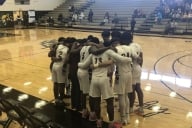You have /5 articles left.
Sign up for a free account or log in.
SAN DIEGO -- "Where do the student-athletes fit into this new governance structure?"
There's lots of applause, then awkward silence, as the half-dozen college presidents who put forth the new plan for the National Collegiate Athletic Association's Division I figure out who will answer the question.
"I'm not sure we've wrestled with that substantially," says Wake Forest University President Nathan Hatch, chair of the Division I Board of Directors. "I think the whole goal of the board is on behalf of the student-athletes."
Day one of two, hours three of seven devoted to discussing the proposed re-structuring that the board will probably approve in August made clear that plenty of questions remain, and many relate to the athletes.
Five of the six proposed "governing principles" for the new iteration of Division I mention education or athlete well-being, but as attendees pointed out, athletes are not represented on the board. Presidents expressed openness to changing that, or giving athletes slots on the committees that will report to the board, but specified that athletes would not be voting members.
The plan put forth is not set in stone, and the point of the dialogue was to hear the concerns of all the Division I members who didn't help write it.
"We'll never have something that everybody says is there," Rice University President David Leebron said. But the ideas can get a majority of the Division I members, he said, and "at the end of the day, we're gonna have a better product for it."
The model, which is very much the product of discontent among colleges in the five Bowl Championship Series conferences, would give the wealthiest athletic programs "legislative autonomy" in areas like financial aid, athlete benefits, health and safety and academic support.
But the presidents emphasized here Thursday that the new structure would allow all of Division I to be more "agile, responsive and strategic" by streamlining many of the cabinets and committees that focus on various issues.
The plan maintains ultimate presidential authority and oversight, but would seek more input from the "practitioners" who have a better understanding of the on-the-ground, practical issues. Athletic directors, faculty athletics representatives and others would manage legislation and rules changes in a new governing group (the Council) that would report directly to the Division I board, while the presidents who comprise the board would focus more on strategic and long-term goals.
In NCAA President Mark Emmert's annual "State of the Association" address Thursday night, Hatch got another shot at the question regarding how the new structure will serve athletes. (Emmert shook things up this year, replacing his one-man monologue with a Q&A with all three division chairs. Hatch followed a teleprompter when responding to the question.)
"Can this change in governance allow Division I to more effectively address the needs of student-athletes?" Emmert asked.
"I think it holds that promise in several respects," Hatch replied, going on to say that with less micromanaging of legislative issues, the board will be able to focus on the core issues of athletes' well-being, academic and professional success.
During the dialogue, a University of Minnesota football player, Chris Hawthorne, noted that the plan makes no mention of professional development of athletes, despite that being a priority among coaches and educators.
Several questions posed by some of the 800 Division I athletic directors, FARs and presidents who attended the dialogue -- easily the most-anticipated event of this four-day convention -- focused on whether the philosophy the presidents were espousing was reflected in the plan, and in the actions of administrators.
"What role do we have as educators in athletics?" Northeastern University Athletic Director Peter Roby asked, before making a clear swipe at the University of Louisville for re-hiring football coach Bobby Petrino, who was dismissed from his last job amid scandal. "Schools are hiring people with bad integrity.... Did any other president call one of their colleagues for making that hire and say, 'What the hell are you doing?' Because that's got nothing to do with education."
In a news conference after Emmert's address, asked whether giving the biggest programs autonomy would result in athletics being prioritized over academics, Hatch said the academic standards would not be lowered.
"More well-resourced conferences should think of upping their standards," he said, for all aspects of athlete welfare.
During the address, Division II Presidents' Council Chair and West Texas University President Patrick O'Brien suggested that if a student wants to persue a more demanding degree but is being hindered by time commitments to a sport, "change the practice time. It's that simple."
But Hatch said at the press conference that it's not really that simple.
"It's very difficult in certain sports like football," he said. "Those practices generally have to be in the afternoon; there's really no other way to do it."
NCAA Executive Committee Chair and Michigan State University President Lou Anna Simon concurred, but said athletes should not have to choose between sport and scholarship.
"I think this is where institutional values take hold as much as NCAA rules," she said.








